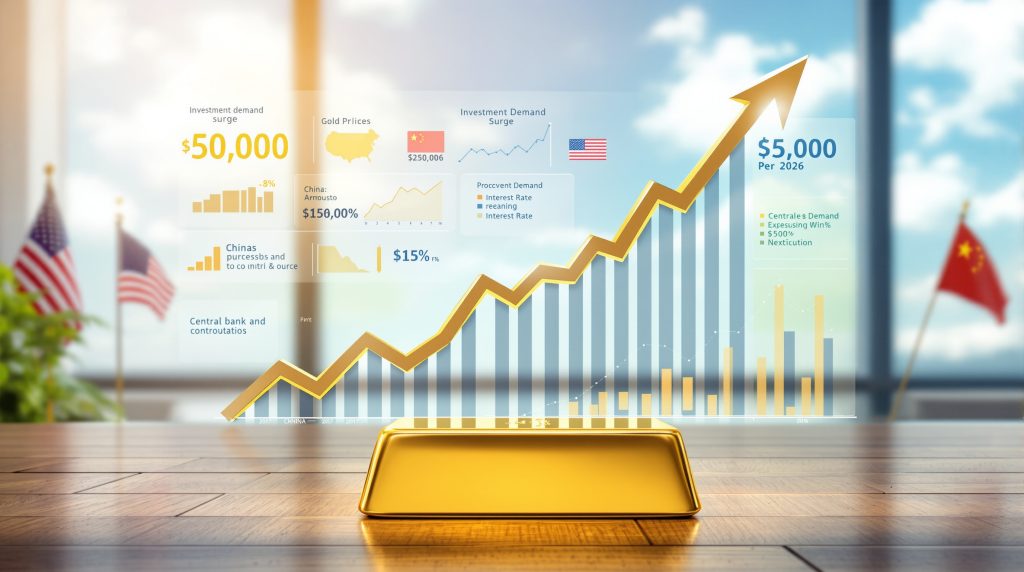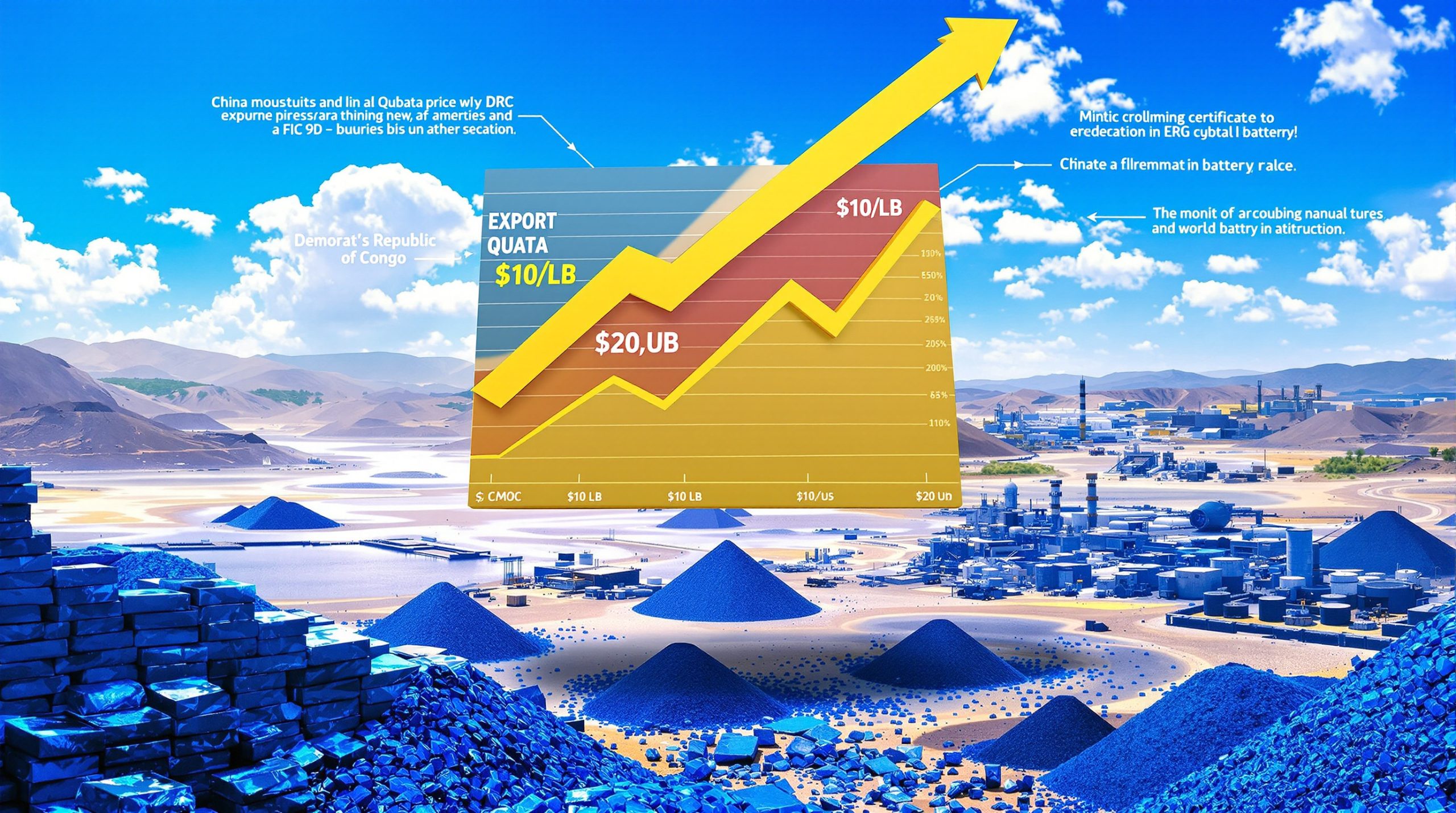What Factors Are Driving Bank of America's Bullish Gold Price Forecast?
Bank of America Global Research has significantly raised its gold price forecast, projecting that the precious metal could reach an impressive $5,000 per ounce by 2026, with an average price around $4,400. This represents a substantial upward revision from previous forecasts and reflects growing confidence in gold's long-term value proposition.
The dramatic upward revision comes as gold recently surged above $4,000 per ounce for the first time in history, reaching a record high of $4,079.62 on October 8, 2025. This milestone price movement has prompted analysts to reconsider their long-term gold price forecast for the precious metal.
Key Drivers Behind BofA's Bullish Gold Outlook
- Investment Demand Surge: Bank of America specifically notes that a 14% increase in investment demand—similar to patterns observed in 2025—could propel gold to the $5,000 mark by 2026
- Safe-Haven Appeal: Renewed tariff threats between major economies have enhanced gold's appeal as a safe-haven asset
- Interest Rate Environment: Expectations of continued interest rate cuts by central banks globally are making non-yielding assets like gold more attractive
- Central Bank Purchasing: Sustained buying from central banks seeking to diversify reserves away from traditional currencies
The investment demand factor appears particularly crucial, as institutional investors increasingly view gold as a portfolio stabilizer during periods of market uncertainty. This shift in asset allocation strategies has been accelerated by recent geopolitical developments and monetary policy decisions.
Physical gold demand has also shown remarkable resilience, with retail investors joining institutional buyers in seeking tangible assets as a hedge against various economic risks. This broad-based demand profile creates a robust foundation for sustained price appreciation.
How Does the Current Gold Price Rally Compare to Historical Movements?
The current gold price rally represents one of the most significant bull markets in the metal's modern history. Gold's breakthrough above the $4,000 threshold in October 2025 marks an unprecedented milestone that few analysts had predicted even a year earlier.
Historical Context of Gold's Price Performance
| Period | Key Price Points | Primary Drivers |
|---|---|---|
| 2020-2022 | $1,700-$2,000 | Pandemic uncertainty, inflation concerns |
| 2023-2024 | $2,000-$3,000 | Geopolitical tensions, central bank buying |
| 2025 | $3,000-$4,000+ | Investment demand surge, monetary policy shifts |
| 2026 (Forecast) | $4,400-$5,000 | Continued investment demand growth, global economic realignment |
Despite the strong bullish outlook, Bank of America acknowledges the risk of a near-term correction. However, the bank maintains that the fundamental factors supporting gold prices remain intact, suggesting that any pullbacks would likely be temporary before resuming the upward trajectory toward their 2026 target.
What makes this rally distinct from previous bull markets is the combination of institutional and retail demand occurring simultaneously, alongside substantial central bank purchases. In previous cycles, these demand sources often moved in different directions, creating more volatile price patterns.
The speed of the current advance has also been remarkable, with gold adding over $1,000 per ounce in less than a year. This rapid appreciation stands in contrast to historical gold bull markets, which typically developed over several years with multiple consolidation phases.
What Are the Implications of $5,000 Gold for Mining Companies?
A gold price environment approaching $5,000 per ounce would transform the economics of gold mining operations worldwide, potentially triggering a wave of new project developments and expansions.
Potential Industry Impacts
- Profit Margin Expansion: Even high-cost producers could see substantial margin improvements
- Reserve Recalculations: Previously uneconomic resources could be reclassified as reserves
- Capital Investment Surge: Increased exploration and development budgets across the sector
- M&A Activity Acceleration: Potential for increased consolidation as companies seek to secure future production
- Production Cost Management: Despite higher prices, miners will need to maintain discipline on costs to maximize benefits
For investors in gold mining equities, a sustained price environment above $4,000 would likely drive significant share price appreciation, particularly for producers with operational leverage to gold prices and companies with development-stage assets approaching production.
The reserve recalculation impact deserves special attention, as many deposits currently classified as sub-economic resources could suddenly become viable reserves at $5,000 gold. This effect is particularly pronounced for lower-grade deposits, where even small changes in cut‐off grade significance can dramatically increase recoverable ounces.
Industry experts note that for every 0.1 gram per tonne reduction in cut-off grade (which becomes possible at higher gold prices), some deposits can see resource tonnage increases of 15-20%. This translates to potentially billions of additional recoverable gold ounces entering global reserves at $5,000 gold.
Many mining executives have maintained conservative price assumptions for reserve calculations, typically using $1,500-$1,800 per ounce even as spot prices moved higher. A sustained move above $4,000 would likely prompt significant upward revisions to these planning assumptions.
How Does BofA's Forecast Compare to Other Major Financial Institutions?
Bank of America's $5,000 gold price forecast for 2026 positions it among the most bullish of major financial institutions, though several other banks have also revised their projections upward following gold's recent performance.
Comparative Gold Price Forecasts for 2026
| Financial Institution | 2026 Gold Price Forecast | Key Rationale |
|---|---|---|
| Bank of America | $5,000 (peak); $4,400 (average) | 14% investment demand growth |
| Goldman Sachs | $4,900 (by Q2 2026) | Central bank demand, ETF inflows |
| JP Morgan | $4,000+ | Strong institutional buying, reserve diversification |
| UBS | $3,500-$4,000 | Monetary policy shifts, inflation hedging |
| Citibank | $3,800-$4,200 | Geopolitical premium, currency debasement concerns |
This divergence in forecasts reflects the different weightings analysts assign to various factors affecting gold prices, including monetary policy expectations, inflation outlooks, geopolitical risk assessments, and anticipated investment flows.
What's notable in the current cycle is that even traditionally conservative forecasters have substantially raised their long-term gold price projections. While specific methodologies differ, most major institutions now acknowledge the structural shifts supporting higher gold prices.
The range of forecasts also highlights the inherent uncertainty in predicting commodity prices, with variations of $1,500 per ounce between the most conservative and most aggressive projections. This spread represents significant potential volatility that investors should consider when building exposure to the sector.
Historical analysis shows that consensus forecasts often lag major price movements in gold, with analysts typically revising projections upward during established bull markets and downward during bear markets. This suggests that the actual price trajectory could deviate substantially from current projections.
What Are the Key Risk Factors That Could Derail the Gold Price Rally?
While Bank of America maintains a bullish outlook for gold through 2026, several risk factors could potentially derail or delay the projected price appreciation.
Primary Risk Considerations
- Monetary Policy Shifts: A more hawkish turn by major central banks could dampen gold's appeal
- Dollar Strength: Unexpected resilience in the US dollar could create headwinds for gold prices
- Investment Demand Volatility: Failure to sustain the projected 14% growth in investment demand
- Technical Correction: Potential for profit-taking following the rapid price appreciation in 2025
- Geopolitical Resolution: De-escalation of major conflicts could reduce gold's safe-haven premium
Bank of America specifically notes the risk of a correction in the near term, suggesting that investors should be prepared for potential volatility even within the context of a longer-term bullish trend.
The monetary policy factor warrants particular attention, as gold's performance has historically been closely linked to real interest rates. If inflation moderates while nominal rates remain elevated, the resulting increase in real rates could significantly impact gold's appeal as a non-yielding asset.
Historical data shows that gold bull markets typically experience several corrections of 10-15% even during long-term uptrends. The speed of the recent advance suggests that a consolidation phase may be necessary before prices can sustainably move toward the $5,000 target.
Market positioning data also suggests potential near-term vulnerability, with speculative futures positioning reaching historically elevated levels. This crowded trade dynamic can sometimes precede sharp but temporary corrections as profit-taking emerges.
How Might Central Banks Respond to Gold at $5,000?
Central banks have been net buyers of gold for over a decade, with purchasing activity accelerating in recent years. A gold price environment approaching $5,000 would likely trigger strategic reassessments among monetary authorities worldwide.
Potential Central Bank Responses
- Reserve Diversification: Continued but potentially more measured accumulation of gold reserves
- Portfolio Rebalancing: Some central banks might rebalance holdings if gold represents an outsized portion of reserves
- Emerging Market Purchasing: Smaller central banks may accelerate purchases to catch up with larger peers
- Strategic Metal Reserves: Potential creation of strategic gold reserves separate from monetary reserves
- Reporting Transparency: Increased scrutiny may lead to more transparent reporting of gold transactions
The behavior of major central banks, particularly those in China, Russia, and India, will be closely watched as key indicators of institutional confidence in gold at these elevated price levels.
Central bank gold reserves have grown by approximately 20% since 2010, with purchasing activity dominated by emerging market economies seeking to reduce dollar dependence. At $5,000 gold, the relative cost of continuing this diversification would increase substantially, potentially moderating the pace of acquisitions.
Historical precedent suggests that central banks tend to be value-oriented buyers, often increasing purchases during price dips rather than chasing rallies. A sustained move to $5,000 might therefore result in more opportunistic rather than systematic buying patterns.
Some monetary experts have suggested that higher gold prices might actually accelerate the establishment of new gold-backed financial instruments by central banks, potentially including digital currencies with partial gold backing. This would represent a significant evolution in how central banks leverage their gold reserves in the modern financial system.
What Investment Strategies Are Recommended for a $5,000 Gold Environment?
For investors looking to position their portfolios for a potential move toward $5,000 gold, several strategic approaches warrant consideration.
Strategic Investment Considerations
- Physical Gold Allocation: Core holdings in physical gold as portfolio insurance
- Gold Mining Equities: Selective exposure to producers with strong operational leverage and disciplined cost management
- Royalty/Streaming Companies: Hybrid exposure with reduced operational risk
- Exploration Companies: Higher-risk allocation to junior miners with significant discovery potential
- Staged Entry Points: Phased investment approach to mitigate timing risk given potential volatility
Bank of America's acknowledgment of near-term correction risk suggests that investors might benefit from maintaining some dry powder to take advantage of potential pullbacks while maintaining core exposure to the sector.
The optimal allocation between physical gold and mining equities depends on investor risk tolerance and investment objectives. Physical gold typically provides lower volatility but also lower potential returns compared to mining stocks, which can deliver significant operational leverage to rising prices.
Royalty and streaming companies present an interesting middle ground, offering exposure to gold price upside with reduced operational risks. These businesses, which provide upfront capital to miners in exchange for a percentage of future production, have historically outperformed both physical gold and traditional mining companies on a risk-adjusted basis during bull markets.
For more risk-tolerant investors, the exploration sector may offer outsized returns in a $5,000 gold environment. Junior companies with promising discoveries would likely attract significant capital in such a price environment, potentially leading to valuation multiples well beyond historical norms.
How Would $5,000 Gold Impact Global Financial Markets?
Gold reaching $5,000 per ounce would represent more than just a price milestone—it would likely signal significant shifts in global financial markets and monetary systems.
Broader Market Implications
- Currency Markets: Potential pressure on fiat currencies, particularly those with weaker fundamentals
- Bond Markets: Possible reassessment of sovereign debt risk premiums
- Equity Valuations: Sectoral rotation favoring hard assets and inflation beneficiaries
- Commodity Complex: Spillover effects lifting other precious metals and commodities
- Monetary System Evolution: Accelerated discussions about the role of gold in a potential new monetary framework
The psychological impact of gold sustaining prices above $4,000 and potentially reaching $5,000 could trigger broader reassessments of asset allocations across institutional portfolios globally.
The currency market implications would likely be significant, with gold's rise potentially coinciding with relative weakness in major fiat currencies. Historical analysis shows that rapid gold price appreciation often reflects declining confidence in the purchasing power of paper currencies rather than increasing intrinsic value of gold itself.
Bond markets could experience notable shifts, with yields potentially rising as investors reassess inflation risks and reduce allocations to fixed income in favor of gold and other real assets. This effect would be particularly pronounced if gold's rise is accompanied by increasing inflation expectations.
Within equity markets, a sectoral rotation favoring companies with strong pricing power, hard asset exposure, and natural inflation hedges would likely accelerate. This would benefit not only gold miners but also broader commodity producers, real estate, and certain consumer staples with pricing power.
The ripple effects across the broader commodity complex would likely be substantial, with silver potentially outperforming gold on a percentage basis due to its historical beta relative to gold prices. Other precious metals and industrial commodities with monetary characteristics might also benefit from spillover investment flows.
What Historical Parallels Exist for Gold's Current Price Trajectory?
While gold's move above $4,000 represents uncharted territory in nominal terms, there are historical parallels that provide context for understanding the current rally.
Historical Analogues
- 1970s Bull Market: Similar drivers including currency debasement concerns and geopolitical tensions
- 2008-2011 Rally: Monetary expansion and financial system concerns driving safe-haven demand
- Post-Bretton Woods Era: Structural shifts in the monetary system creating sustained revaluation
Adjusted for inflation, gold's current price levels are approaching but have not yet exceeded the inflation-adjusted peaks of 1980, suggesting that further upside remains possible from a long-term historical perspective.
The 1970s parallel is particularly instructive, as that decade saw gold prices rise approximately 2,300% following the abandonment of the gold standard. The current environment shares several characteristics with that period, including monetary expansion, geopolitical tensions, and inflation concerns.
However, important differences exist, particularly regarding the starting point. In 1971, gold was artificially suppressed at $35 per ounce through government policy, creating significant pent-up revaluation potential once those restrictions were removed. Today's market begins from a more market-determined price level.
The 2008-2011 rally provides a more recent parallel, with gold rising from approximately $700 to $1,900 per ounce amid financial system stress and unprecedented monetary expansion. The current environment features even more extensive monetary intervention globally, potentially supporting a more dramatic price response.
From a longer historical perspective, gold's price movements often reflect structural shifts in the global monetary system. The post-Bretton Woods era has seen several such shifts, with gold prices responding to changes in reserve currency dynamics, central bank policies, and international financial architecture.
FAQ: Understanding Bank of America's Gold Price Forecast
Why is Bank of America forecasting gold to reach $5,000 by 2026?
Bank of America's forecast is primarily based on projected investment demand growth of approximately 14% through 2026, similar to patterns observed in 2025. This demand growth, combined with monetary policy expectations and ongoing central bank purchases, creates a favorable environment for sustained price appreciation.
The bank's analysis suggests that the current gold rally represents more than a cyclical movement, indicating a potential structural shift in how investors and institutions view gold within the global financial system. This perspective aligns with observed changes in central bank reserve management practices and institutional portfolio allocations.
Technical gold analysis supporting this price target includes long-term trend analysis, retracement levels from previous bull markets, and projections based on historical volatility patterns. These technical factors complement the fundamental demand-driven thesis underpinning the $5,000 target.
What would $5,000 gold mean for inflation expectations?
Gold reaching $5,000 would likely reflect heightened inflation concerns among investors, though it doesn't necessarily predict higher realized inflation. Rather, it would signal diminished confidence in central banks' ability to maintain price stability through conventional monetary policy tools.
Historical analysis shows that gold prices tend to rise most dramatically not during periods of high realized inflation, but during times when confidence in monetary authorities is declining. This distinction is important for understanding the relationship between gold prices and actual inflation outcomes.
Some economists argue that gold's rise may itself contribute to changing inflation expectations through psychological channels, potentially becoming a self-reinforcing cycle. Central banks would likely closely monitor this feedback loop between asset prices and inflation expectations.
How might gold mining companies change their operations if prices reach $5,000?
At $5,000 gold, mining companies would likely reassess their reserve calculations, potentially bringing lower-grade deposits into production. Capital allocation strategies would shift toward growth, though companies that maintain cost discipline would be best positioned to maximize shareholder returns in this environment.
Mine life extensions would become economically viable for many operations as lower cut-off grades expand recoverable reserves. This could significantly extend the productive life of existing operations without requiring new capital development.
Exploration budgets would likely expand substantially, with particular focus on districts with known mineralization but historically sub-economic grades. Areas previously considered marginal or uneconomic could attract renewed interest and substantial capital investment.
Processing technologies for complex or refractory ores would likely see accelerated development, as higher gold prices justify more extensive metallurgical processing to recover previously uneconomic gold. This could unlock significant resources currently classified as too difficult to process economically.
Could gold reach $5,000 before 2026?
While Bank of America's forecast targets 2026 for the $5,000 level, accelerated investment flows or acute geopolitical crises could potentially compress this timeline. However, the bank's acknowledgment of near-term correction risk suggests a more measured pace of appreciation is their base case.
The path to $5,000 would likely include periods of consolidation and potential retracement, consistent with historical bull market patterns. These consolidation phases often prove healthy for extending bull markets by clearing overleveraged positions and establishing new technical support levels.
Scenario analysis suggests that specific trigger events—such as major central bank policy shifts, significant geopolitical escalations, or systemic financial stress—could accelerate the timeline. Under such circumstances, price movements could become more parabolic, potentially reaching the $5,000 target ahead of the projected timeframe.
What signals would indicate that the $5,000 target might not be reached?
Key indicators that might challenge the $5,000 forecast include sustained dollar strength, a shift toward more hawkish monetary policy, significant liquidation of gold ETF holdings, or a substantial reduction in central bank purchasing activity.
Technical warning signs would include failure to maintain support at key psychological levels (such as $4,000), declining volume during price advances, or negative divergence between gold prices and mining equity performance. These patterns have historically preceded meaningful corrections in previous bull markets.
Positioning data showing extreme bullishness among speculative traders would also raise caution flags, as crowded positioning can create vulnerability to sharp corrections when sentiment shifts. The commitment of traders report provides valuable insights into this market dynamic.
Further Exploration:
Readers interested in learning more about gold safe‐haven insights and market analysis can also explore related educational content available from Mining Weekly, which offers additional perspectives on precious metals markets and mining sector developments.
The World Gold Council publishes regular research on gold market trends, central bank activities, and investment flows, providing valuable data for understanding the fundamental factors driving price movements.
For those interested in the technical aspects of gold mining economics, resources from major mining consulting firms offer insights into how changing price environments affect project economics, reserve calculations, and industry capital allocation decisions.
Understanding the historical context of gold bull markets can provide valuable perspective, with several academic studies and financial history texts examining previous cycles in detail, including the 1970s bull market and the 2008-2011 rally.
For investors looking to incorporate gold into their portfolios, developing a strategic gold investment approach that aligns with individual risk tolerance and financial goals remains essential regardless of price forecasts.
Ready to Capitalise on the Next Major Gold Discovery?
Explore how Discovery Alert's proprietary Discovery IQ model delivers real-time alerts on significant ASX mineral discoveries, transforming complex data into actionable investment insights before the broader market. Visit the Discovery Alert discoveries page to understand how historic mineral discoveries have generated substantial returns for early investors.




